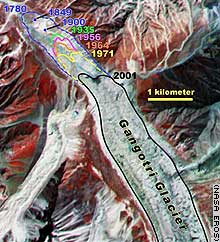| |||
| Member Services | |||
|
|
|
|
||||||||||||||||||||||
Water crisis looms as Himalayan glaciers melt

This composite image shows
how the Gangotri Glacier terminus has retracted since 1780 to 2001. SPECIAL REPORT
• Flash: Hot
spots around the globe
• Explainer: Global
warming
YOUR E-MAIL ALERTSNEW DELHI, India (Reuters) -- Imagine a world without drinking water. It's a scary thought, but scientists say the 40 percent of humanity living in South Asia and China could well be living with little drinking water within 50 years as global warming melts Himalayan glaciers, the region's main water source. The glaciers supply 303.6 million cubic feet every year to Asian rivers, including the Yangtze and Yellow rivers in China, the Ganga in India, the Indus in Pakistan, the Brahmaputra in Bangladesh and Burma's Irrawaddy. But as global warming increases, the glaciers have been rapidly retreating, with average temperatures in the Himalayas up 1 degree Celsius since the 1970s. A World Wide Fund report published in March said a quarter of the world's glaciers could disappear by 2050 and half by 2100. "If the current scenario continues, there will be very little water left in the Ganga and its tributaries," Prakash Rao, climate change and energy program coordinator with the fund in India told Reuters. "The situation here is more critical because here they depend on glaciers for drinking water while in other areas there are other sources of drinking water, not just glacial." Experts are alarmed. About 67 percent of the nearly 12,124 square miles of Himalayan glaciers are receding and in the long run as the ice diminishes, glacial runoffs in summer and river flows will also go down, leading to severe water shortages in the region. The Gangotri glacier, the source of the Ganga, India's holiest river, is retreating 75 feet a year. And the Khumbu Glacier in Nepal, where Edmund Hillary and Tenzing Norgay began their ascent of Everest, has lost more than 3 miles since they climbed the mountain in 1953. "The cry in the mountains is that water has gone down and springs have dried up," Jagdish Bahadur, an expert on Himalayan glaciers. "Global climate change has had an effect, but water has also dried up because agriculture in the mountains has increased," he said. In Nepal, there are more than 3,000 glaciers that work as reservoirs for fresh water and another 2,000 glacial lakes. Experts estimate numerous rivers originating in Nepal's mountains contribute about 70 percent to the pre-monsoon flow of the Ganges that snakes through neighboring India and Bangladesh. "The glaciers are shrinking due to global warming posing a risk to water availability not only in Nepal but also in parts of South Asia," said Arun Bhakta Shrestha, an expert on Himalayan glaciers at the government Hydrology and Meteorology Department. "But how soon or to what extent this problem will arise is difficult to say now." Tulsi Maya, a farmer on the outskirts of Kathmandu, has never heard of global warming or its impact on the rivers in the Himalayan kingdom, but she does know that the flow of water has gone down. "It used to overflow its banks and spill into the fields," the 85-year-old farmer said standing in her emerald green rice field as she looked at the Bishnumati river, which has ceased to be a reliable source of drinking water and irrigation. "Maybe God is unkind and sends less water in the river. The flow of water is decreasing every year," she said standing by her grandson, Milan Dangol, who weeds the crop. In the Indian Himalayas, there are already signs of water shortages in the summer: Tourists in the rugged mountains of Ladakh and Himachal Pradesh have to carry buckets of water while trekkers say temperatures are much warmer than a decade ago. The effect can also be seen in the rest of the country. During the summer, thousands of people in India's villages trek for miles in search of water and even in cities water is a precious commodity, sometimes leading to street fights. Indian scientists studying Himalayan glaciers fear an acute shortage of natural drinking water in Himachal Pradesh state based on studies of the Beas and Baspa basins from 1962 to 2001. Two scientists from India's Space and Research Organization using remote sensing satellites found a 23 percent drop in glacial water in 19 of 30 glaciers mapped in the region. Already, the impact of climate change is evident in the soaring summer temperatures in South Asia, which go up to 122 degrees Fahrenheit, and the erratic nature of the monsoon, one of the world's most widely watched phenomena. "Our research indicates the economy of the region may be affected due to these conditions and investigations suggest that all glaciers are reducing which could create an acute scarcity of water," said Anil Kulkarni, who headed the team studying the Himachal Pradesh glaciers. Copyright 2005 Reuters. All rights reserved.This material may not be published, broadcast, rewritten, or redistributed.
|
| |||||||||||||||||||||
| © 2005 Cable News Network LP, LLLP. A Time Warner Company. All Rights Reserved. Terms under which this service is provided to you. Read our privacy guidelines. Contact us. |
|
